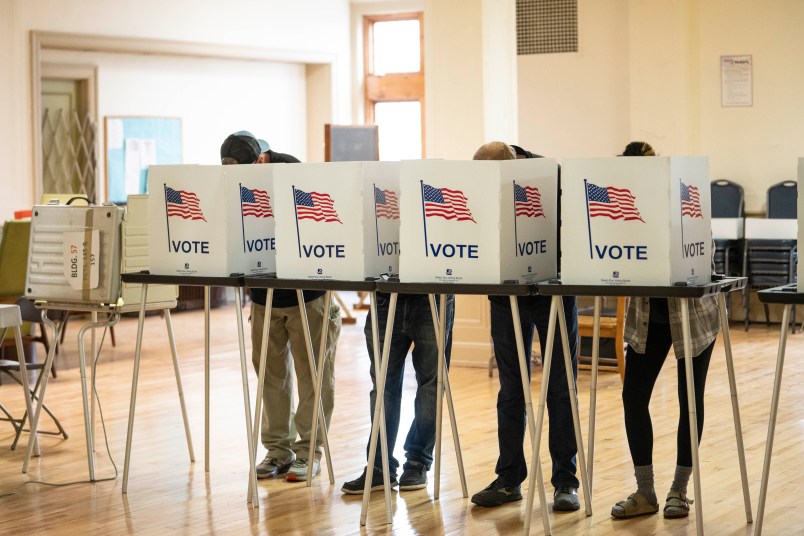If current trends hold, former Vice President Joe Biden is on track to win the White House with 306 electoral votes — a not particularly close presidential election.
But when the relative tightness of the race in individual states is combined with the particularities of their recount procedures, we could see a scenario where a projected Joe Biden victory will be followed by multiple states recounting their ballots.
Multiple recounts should not, by themselves, be construed as a signal that the overall election result is likely to overturned – no matter what President Trump might claim. Because of the way recount rules work, some states could go into recounts even if their margin are not close enough to plausibly put them in Trump’s column. Meanwhile, the states where a recount could decide who gets those particular electoral votes aren’t the ones that Biden is relying on to carry him to 270.
Here’s a state-by-state look at the dynamics at play:
Georgia: Georgia’s election officials have already confirmed that the state is heading to a recount. Biden’s current lead is razor thin — 1,579 votes — and almost certain to remain within the .5 percentage point margin that triggers an an automatic recount under state law.
The good news for Biden is that there are many ways for him to win the White House at this point that won’t depend on Georgia. And most of those paths run through states where, even with recounts, the results are extremely unlikely to change. But Democrats will have to wait until late November, at least, to find out if they eked out a presidential win in the Peach State for the first time since 1992. That’s how long a top state elections official said on Friday that a recount would take.
Wisconsin: Trump’s campaign has already said that it will seek a recount in the Badger State, a totally legitimate request for the campaign to make. Wisconsin recount laws allow the candidates to request a recount when the margin is under 1 percent. The unofficial tabulation of the state’s votes shows Biden at .6 percentage points over Trump.
The problem for Trump is that he’s nonetheless well out of the range of the kind of vote changes Wisconsin recounts have historically produced. A recount of the 2016 presidential election — triggered by a Jill Stein request — changed the count by 131 votes. A 2011 recount of a state Supreme Court race swung about 300 votes. Biden is up by more than 20,000 votes.
The bigger question, perhaps, is whether the reportedly cash-strapped Trump campaign will really want to pay for the recount itself. Under state law, taxpayers only cover recounts where the margins are .25 percent or lower.
Arizona: There are no options in Arizona for candidates (or voters aligned with their campaigns) to request a recount. The only trigger is a close margin, which in a presidential contest, would require a race separated by just .1 percentage points. Given the number of ballots left still to count, Biden’s current 43,000 vote lead is still considered a close one. But the current margin is well outside that automatic trigger range, and Trump will have to significantly over-perform current expectations to narrow it sufficiently. Just as importantly, however, is that as long as Biden holds on to Wisconsin, Michigan, and Pennsylvania, losing Arizona won’t put him below 270 electoral votes.
Nevada: Biden’s narrow 22,000 vote Nevada lead is expected to widen as ballots from Democratic-leaning Clark County provide the bulk of what remains. But no matter where the final tally lands, with no automatic recount trigger under Nevada law, it will then fall on Trump or his allies to request a recount. And if they do, they’ll have to overcome some preliminary tests before a recount is conducted statewide. First they’ll get to chose a set of sample precincts that amount to 5 percent of the ballots cast, and a recount will happen there. Only if that recount shows a discrepancy from the original canvas of 1 percent of more can the candidate then ask for a statewide recount — but even then, it would still be within the secretary of state’s discretion whether to order such a recount to go forward.
Pennsylvania: Pennsylvania, like Georgia, has an automatic recount trigger for close races with margins of .5 percentage points or less. The current count is within the margin, but tens of thousands of mail ballots have yet to be counted, so Biden running up the score in the final stretch could put an automatic recount off the table. In that scenario, the possibility of a recount would then depend on voters initiating such a petition. They could file such a petition before individual county boards, or in court. But, as the Stein’s 2016 failed bid for a full Pennsylvania recount showed, this scattershot approach is complicated and costly when it comes to getting a recount statewide.
It seems possible, given Trump’s pattern so far zeroing in on Pennsylvania, we could see such an effort mounted. But current trends don’t suggest that Pennsylvania will be so close that a recount will change the results, and as as long as Arizona and Nevada remain in Biden’s column, Biden’s path to 270 won’t depend on Pennsylvania, anyway.
Michigan: Trump is well outside the close-margin range (2,000 votes or less) that would trigger an automatic recount under Michigan state law. The only other scenario, per state law, where Trump could get a recount is one where he was able to put forth a “good-faith” allegation that there had been “fraud or mistake” that was preventing him from having “a reasonable chance of winning the election.” So far, Trump and his allies have struggled to find any such evidence in the election litigation they’ve already mounted.











Today is a good day.
Also, this made me chuckle:
I am not sure Biden’s lead in Georgia is going to hold, but that should be little comfort for Georgia Republicans. The electorate has shown that it is shifting away from the old line white conservative Republicans. Republicans in Georgia who don’t modify their approach will go extinct very soon. Well done Georgia Democrats, well done, indeed.
Two more than Cockholster was awarded in 2016. Irony or poetry?
‘Cause the majority of 2020 voters think he’s a psychopathic clown with launch codes and an Executive Order to deify the imperial family?
(Just a guess, mind you.)
A win is a win, but 70 million people voted to continue this shitshow of a presidency - sad.